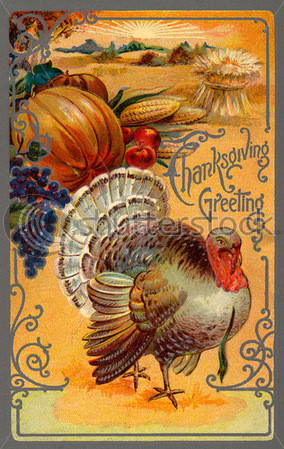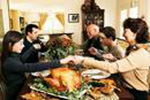
History of Thanksgiving
For thousands of years, mankind has set aside a day each year to celebrate bountiful annual harvests. Before the establishment of formal religions, many ancient farmers believed that their crops contained spirits which caused the crops to grow and die. Many believed that these spirits would be released when the crops were harvested and they had to be destroyed or they would take revenge on the farmers who harvested them. Some of the harvest festivals celebrated the defeat of these spirits. Harvest festivals and Thanksgiving celebrations were held by the ancient Greeks, the Romans, the Hebrews, the Chinese, and the Egyptians.
What is the history of Thanksgiving in United States? The initial "Thanksgiving" feast, held in 1621, was really a traditional English harvest celebration. The Pilgrims shared it with the Native Americans because they had taught the colonists to plants crops and hunt wild game. Without the Native Americans, the Pilgrims may not have survived the harsh winter and been able to celebrate their first harvest of plentiful crops in the New World.
The colonists' first harvest feast lasted for three days. Food was served all at once, instead of in courses, so people ate whatever they pleased in the order that they desired. The more important members at the feast were given the best pieces of meat, while the rest of the diners ate whatever was closest to them. Since the Pilgrims didn't use forks or plates, they ate their meal straight off the table with spoons, knives or their fingers. They used large napkins to wipe their hands and also wrapped it around food when it was too hot to hold.
The history of Thanksgiving demonstrates that feasts like the one at Plymouth were held throughout the colonies after fall harvests. However, all thirteen colonies did not celebrate Thanksgiving at the same time. In 1789, George Washington became the first president to declare Thanksgiving a holiday. By the mid-1800s, many states observed the Thanksgiving holiday. Meanwhile, the poet and editor, Sarah J. Hale, had begun lobbying for a national Thanksgiving holiday. During the Civil War President Abraham Lincoln looking for ways to unite the nation, discussed the subject with Hale. In 1863 he gave his Thanksgiving Proclamation declaring the last Thursday in November a day of Thanksgiving.
In 1939, 1940, and 1941 Franklin D. Roosevelt, seeking to lengthen the Christmas shopping season, proclaimed Thanksgiving the third Thursday in November. Controversy ensued, and Congress passed a joint resolution in 1941 decreeing that Thanksgiving should fall on the fourth Thursday of November, where it remains. What is Thanksgiving today? At its heart, it's a holiday where family and friends congregate to catch up, reminisce, tell jokes, share scrumptious food and generally give thanks for all the good things in life-exactly what they did at the very first Thanksgiving.

Thanksgiving Traditions
What would Thanksgiving be without its many traditions? Perhaps the most special thing about the holiday is the opportunity it affords people to take the day off from work and spend time with friends and loved ones, sharing feelings of gratitude for all the good things in life. Some people also use the holiday as an opportunity to attend special church services held in the morning.
Prayer traditions before Thanksgiving meals vary widely from family to family. Often, prayers are said every year by the same family member, giving thanks for the countless blessings enjoyed. Some families prefer to rotate members, so every year; a different family member says the Thanksgiving prayer. Even more popular, every member says their personal prayer out loud, taking turns.
Of course, everyone looks forward to the grandest tradition of all-the Thanksgiving dinner. Thanksgiving dinner consists of turkey, stuffing, mashed potatoes, olives, cranberries and a whole variety of individual preferences. Baked pumpkin and apple pie covered with heaps of whipped topping seems to be the most popular choice for dessert. The same tablecloth, dishes and silverware are often used year after year and are part of the Thanksgiving meal. While is doesn't change how the food tastes, it does indeed set the mood for Thanksgiving festivities.
Another Thanksgiving tradition is the annual Macy's Thanksgiving Day Parade held in New York City. If you can't get to the parade itself, at least you can watch the marching flotilla on television. The parade, which began in 1927, is a favorite for children with balloons, floats and characters larger than life. If you have a large family, you might also want to spend Thanksgiving Day drawing names for Christmas gifts. Have everyone complete wish lists and circulate them around. Be careful to set price limits. And remember, Christmas sales start the day after Thanksgiving!
As anyone who follows sports can tell you, Thanksgiving Day is also a big day for televised sporting events. Football is a big part of the day-half the family can help you clean up after the Thanksgiving feast, while the other half remains glued to the tube. If you're lucky enough to find a stray man wandering into the kitchen by accident, you can put him to work on the dishes!
Lastly, every family seems to have its own unique Thanksgiving traditions. Whatever yours are, make sure to kick back and enjoy this very special holiday.
